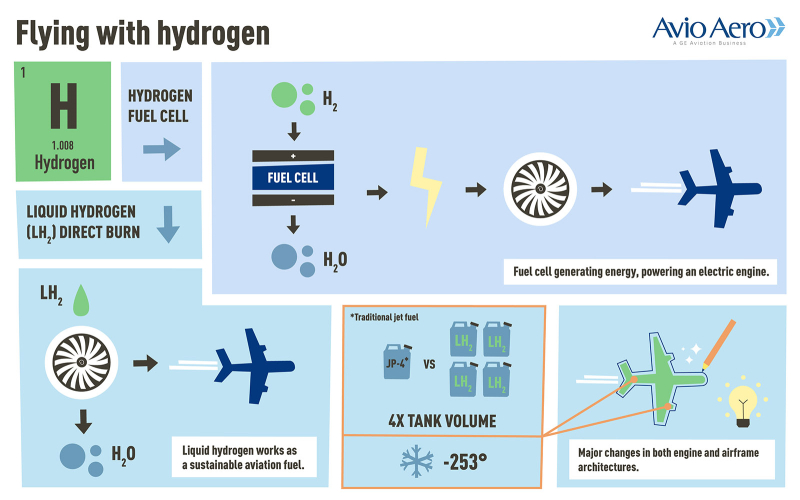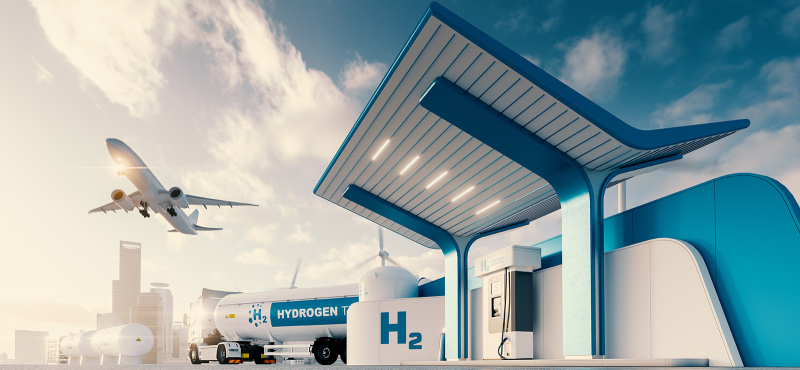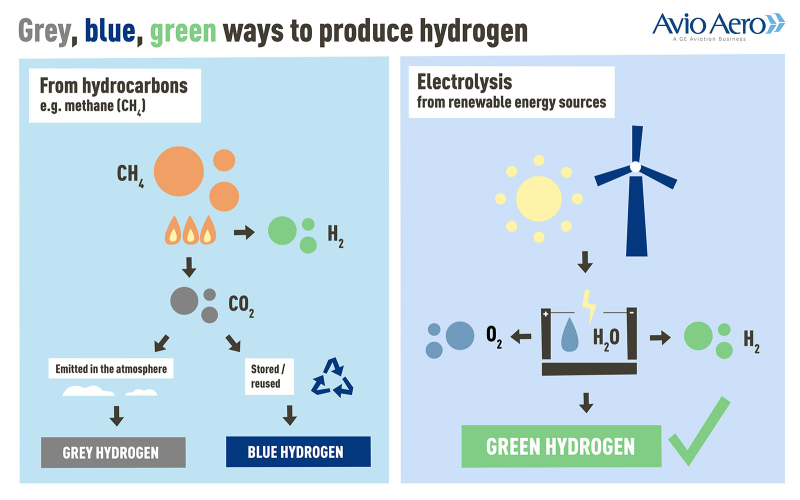Future
How flying on hydrogen works
One of the technological keys to decarbonisation of air transport is based on the first element of the periodic table, and its ongoing development work promises zero carbon emissions.
Jan 2022
According to many scholars, including scientists from United Nations Intergovernmental Panel for Climate Change (IPCC), by 2050 almost 85% of the energy consumed globally by humans will be electric and produced primarily from renewable sources. At the same time, the gradual phasing out of fossil fuels (coal, oil and methane) will reduce CO2 emissions that cause global warming, contributing to the planet’s vital goal of keeping the increase in the Earth's temperature to below 1.5°C.
Also in transport, electricity and renewables are central to reducing emissions generated by the movement of goods and people around the world. Aviation, which accounts for approximately 2% of total emissions of CO2 generated by humans, has for years been focusing on the electrification of flight and fuels produced from renewable natural resources or organic waste (Sustainable Aviation Fuels).
However, there is still another ace up the sleeve of aeronautical research, an element that on the one hand is regarded as SAF (of non “drop-in” type), and on the other can be exploited in a second way for aeronautical propulsion: hydrogen. An element that is abundant in nature and at the center of the development of new technologies and propulsion architectures.
In fact, hydrogen can power an aircraft engine mainly in two ways: the first is through a fuel cell, a device based on an electrochemical reaction produced through the ionization of hydrogen and oxygen, which is capable of generating electrical energy that powers electric motors and is stored in batteries.
The second is the direct combustion of hydrogen, in this case liquid (LH2), which just like SAF would totally replace traditional aviation fuel and therefore (as a non-drop-in type) require important technology investment on the engine architecture and radical changes to the aircraft’s configuration. This is primarily due to the energy density of hydrogen which - by volume unit - is about 4 times lower than that of kerosene.
Jennifer Pogliano, part of the team at Avio Aero that works on European research programs and interacts with a network of universities and specialized centers across the continent, has been working on emerging decarbonisation technologies. Today, together with other European colleagues from Avio Aero and GE, she is totally dedicated to the challenge presented by hydrogen.
“The task is far from trivial, but if the industry's efforts can count on adequate institutional support, we can expect a liquid hydrogen powered airplane by 2035 on the market,” said Jennifer. “Clearly, at the same time, the infrastructure system will also have to be prepared and adapted to the peculiarities of this fuel.”
This is the other aspect that complicates the task of engineers and researchers in getting hydrogen-powered aircraft into the air: hydrogen - which even in liquid form would require tanks approximately 3-4 times larger, significantly affecting the shape and size of the aircraft - needs to be stored at temperatures as low as -253°C to maintain its liquid state.
“Given the low volumetric energy density of hydrogen fuel, the fuselage will likely have to be rethought,” added Jennifer, “also, the entire fuel distribution, vaporization and supply system, before the combustion chamber, will have to be designed to sustain cryogenic temperatures, while preventing unexpected evaporation and leaks, or material embrittlement. These two points already give an idea of the technology and safety challenges ahead, in an industry where safety is paramount.”
In principle, any aircraft engine, be it turboprop or turbofan, can operate using hydrogen. As Thomas Ripplinger, an expert from the Advanced Aviation Technology team in Munich (Germany), and an adept in thermal sciences and gas turbomachinery, confirms. Before joining GE, he worked for major industry players such as MTU and Pratt & Whitney.
“Theoretically, a hydrogen engine works just like a kerosene gas turbine, except that it has internal components that have been redesigned to work with liquid hydrogen: primarily the combustor, refueling system and turbines,” explained Thomas. “Turboprop engines are widely used in the private, short haul or regional segment, so focusing on hydrogen technology for turbofans, which are used in engines for medium or long range, single or twin-aisle aircraft, would have a clearly greater impact in lowering air transport’s CO2 emissions.”
According to Thomas Ripplinger - as well as other colleagues from Avio Aero and Federated European Engineering at GE Aviation who, in various ways, are involved in the historical technological challenge also conducted in collaboration with the engineering department in the US headquarters - there have already been presented proposals for a wide range of options for the shape and configuration of hydrogen aircraft.
“Aircraft of the future, with liquid hydrogen powered engines, could be almost the same as modern ones, storing LH2 in the fuselage, for example. Up to and including completely new contours for civil aviation: like flying wings capable of carrying hydrogen tanks in the wing body on intercontinental flights. The type of configuration will depend primarily on the date of entry into service of the aircraft and its envisaged range,” added Thomas.
Another key issue for aeronautical research is the production of hydrogen, namely the type of production: to date, hydrogen can be created from hydrocarbons or water, by means of thermolysis or electrolysis processes that require the consumption of energy. There are also biotechnological processes, such as extraction from algae or waste, and processes based on nuclear fusion (that is still under study).
“For hydrogen use to be truly 'carbon free,' we need to look at the emissions all along the supply chain,” explained Jennifer. “based on the production process, we can identify ‘grey’, ‘blue’ and ‘green’ hydrogen: the first two derive from hydrocarbons (such as methane) through a CO2 – emitting process, which, in the case of blue hydrogen only, is partially captured or assimilated, while green hydrogen is obtained through the electrolysis of water activated through renewable resources (solar, wind, etc.) and is 100% sustainable.”
GE Aviation's vision, which aims to achieve net zero carbon emissions by 2050, therefore focuses on three technological sources – SAF (drop-in type), hybrid-electric engines and hydrogen - and for the latter, the most pioneering, the commitment and involvement of specialists is truly global: from America, to Europe, to Asia with centers in Turkey and Bangalore. “We have the opportunity to rely on excellent expertise,” said Thomas, “as well as government-sponsored programs and the infrastructure of our global sites.”
“At Avio Aero - in the scope of GE’s global challenge, and in collaboration with the key industry players, universities, R&D centers and SMEs - we are ready to take on the mission stated within the Strategic Research and Innovation Agenda by the Clean Aviation - Joint Undertaking” added Jennifer.
Of course, the connection with Clean Aviation will once again be fundamental: in fact, the public-private partnership with the European Commission identified three key thrusts for the R&I efforts which have been identified that will drive the energy efficiency and the emissions reductions of future aircraft.
These three are hybrid-electric and fully electric engine architectures and their digital integration with engine and aircraft; architectures making use of highly integrated and ultra-efficient thermal propulsion systems, improved in fuel efficiency, (essential for the transition to low/zero emission energy sources which will be more energy intensive to produce, more expensive, and only available in limited quantities); and, new disruptive technologies to enable aircraft and engines to exploit the potential of hydrogen as a non-drop-in alternative zero carbon fuel (in particular liquid hydrogen).
“The ambition for hydrogen to power the flights of tomorrow will need solid advocacy by the governments and institutions, due to the complexity of the endeavor and size of investments” concluded Jennifer. “We are ready to act as promoters in the dialogue between all the actors involved, with the aim of demonstrating the feasibility and benefits of a technological solution that has the potential to open a new era of aviation”.







